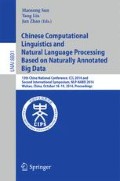Abstract
When mining parallel text from comparable corpora, we confront vast search space since parallel sentence or sub-sentential fragments can be scattered throughout the source and target corpus. To reduce the search space, most previous approaches have tried to use heuristics to mine comparable documents. However, these heuristics are only available in few cases. Instead, we go on a different direction and adopt the cross-language information retrieval (CLIR) framework to find translation candidates directly at sentence level from comparable corpus. What’s more, for the sake of better retrieval result, two simple but effective query expansion methods are proposed. Experimental results show that using our query expansion methods can help to improve the recall significantly and obtain candidates of sentence pairs with high quality. Thus, our methods can help to make good preparation for extracting both parallel sentences and fragments subsequently.
Access this chapter
Tax calculation will be finalised at checkout
Purchases are for personal use only
Preview
Unable to display preview. Download preview PDF.
References
Church, K.W., Hanks, P.: Word association norms, mutual information, and lexicography. Computational Linguistics 16(1), 22–29 (1990)
Fung, P., Cheung, P.: Mining very non-parallel corpora: Parallel sentence and lexicon extraction vie bootstrapping and EM. In: EMNLP 2004, pp. 57–63 (2004a)
Fung, P., Cheung, P.: Multi-level bootstrapping for extracting parallel sentences from a quasi-comparable corpus. In: COLING 2004, pp. 1051–1057 (2004b)
Jang, M.-G., Myaeng, S.H., Park, S.Y.: Using Mutual Information to Resolve Query Translation Ambiguities and Query Term Weighting. In: Proceedings of the 37th Annual Meeting of the Association for Computational Linguistics on Computational Linguistics (1999)
Liu, C., Liu, Q., Liu, Y., Sun, M.: THUTR: A Translation Retrieval System. In: Proceedings of the 24th International Conference on Computational Linguistics, pp. 321–328
Adriani, M.: Using statistical term similarity for sense disambiguation in cross-language information retrieval. Information Retrieval 2(1), 71–82 (2000)
Maeda, A., Sadat, F., Yoshikawa, M., Uemura, S.: Query term disambiguation for web cross-language information retrieval using a search engine. In: Proceedings of the Fifth International Workshop on Information Retrieval with Asian Languages, pp. 25–32. ACM (2000)
Munteanu, D.S., Marcu, D.: Improving machine translation performance by exploiting non-parallel corpora. Computational Linguistics 31(4), 477–504 (2005)
Munteanu, D.S., Marcu, D.: Extracting parallel sub-sentential fragments from nonparallel corpora. In: Proceedings of the 21st International Conference on Computational Linguistics and the 44th Annual Meeting of the Association for Computational Linguistics, Sydney, Australia, pp. 81–88 (2006)
Rauf, S., Schwenk, H.: Parallel sentence generation from comparable corpora for improved SMT. Machine Translation 25(4), 341–375 (2011)
Smith, J.R., Quirk, C., Toutanova, K.: Extracting parallel sentences from comparable corpora using document level alignment. In: Proceedings of the Human Language Technologies/North American Association for Computational Linguistics, pp. 403–411 (2010)
Tillmann, C.: A Beam-Search extraction algorithm for comparable data. In: Proceedings of ACL, pp. 225–228 (2009)
Ture, F., Lin, J.: Why not grab a free lunch? Mining large corpora for parallel sentences to improve translation modeling. In: HLT-NAACL, pp. 626–630 (2012)
Xiang, L., Zhou, Y., Zong, C.: An Efficient Framework to Extract Parallel Units from Comparable Data. In: Natural Language Processing and Chinese Computing, pp. 151–163 (2013)
Ştefănescu, D., Ion, R., Hunsicker, S.: Hybrid parallel sentence mining from comparable corpora. In: Proceedings of the 16th Conference of the European Association for Machine Translation (EAMT 2012), Trento, Italy (2012)
Author information
Authors and Affiliations
Editor information
Editors and Affiliations
Rights and permissions
Copyright information
© 2014 Springer International Publishing Switzerland
About this paper
Cite this paper
Xiang, L., Zhou, Y., Hao, J., Zhang, D. (2014). Query Expansion for Mining Translation Knowledge from Comparable Data. In: Sun, M., Liu, Y., Zhao, J. (eds) Chinese Computational Linguistics and Natural Language Processing Based on Naturally Annotated Big Data. NLP-NABD CCL 2014 2014. Lecture Notes in Computer Science(), vol 8801. Springer, Cham. https://doi.org/10.1007/978-3-319-12277-9_18
Download citation
DOI: https://doi.org/10.1007/978-3-319-12277-9_18
Publisher Name: Springer, Cham
Print ISBN: 978-3-319-12276-2
Online ISBN: 978-3-319-12277-9
eBook Packages: Computer ScienceComputer Science (R0)

